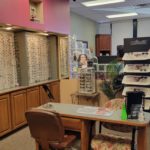
The optical at Azle Vision Source, where Nicole Lovato serves as practice manager. She says a few key changes have boosted the practice’s eyewear capture rate by 15 percent.
By Nicole Lovato
Oct. 27, 2021
Eyewear capture rate is an indication both of how well you are caring for patients and how well you are generating revenues. You want your patients to leave with all the eyewear the doctor has prescribed, and you want them to buy those products from you.
As a practice manager, I have seen the great impact on patients and profitability that a concerted effort to improve capture rate can make.
It’s not enough to schedule eye exams. In this day and age with online retailers, and large chains with overwhelming buying power, we have to do all we can to keep our patients from going elsewhere.
We were able to improve our eyewear capture rate by making small changes to how we do business. By implementing a few minor changes, we increased our capture rate 15 percentage points from 45 percent to 60 percent. Here is how we did it.
Staff Now Discusses Great Insurance Benefits
We changed the way we approach patients. We trained our opticians to begin as many patient interactions as possible with, “Wow, you have great insurance benefits!” They then ask the question, “Would you like to look at glasses today or order some contact lenses?”
You would be shocked at the number of patients who purchase at our office who previously told other staff members that they didn’t intend to purchase from us. Our staff is now trained to disregard this statement from the patient and continue to treat the patient as though they plan to purchase glasses in our office. The key to making this a success is following-up with staff members and observing them to make sure they continue to use this protocol and those specific phrases.
Doctors Now Recommend Specific Lens Treatments
We have two optometrists at our practice, and have been able to see first-hand the difference recommendations from the doctor in the exam room makes. We have one doctor who always mentions after the refraction that the patient should be sure to get anti-reflective lenses and a good-quality pair of sunglasses. The patients seen by this doctor typically come out asking our opticians about these options. We have seen an increase in the number of sunglasses sold since adding this doctor to our practice, and AR is a much easier sell when the patient has already been told about it, and had it recommended to them, by the doctor.
I am actively working with our other doctor to talk to patients about sunglasses and AR in the exam room, as we know the influence on patients of hearing about sunwear and AR from the doctor, rather than just having the optician tell them about it.
Other Articles to Explore
I have found it is a matter of consistency and working the verbiage into the exam-room routine that is necessary to make this change a success.
We Now Seat Patients in the Optical
After each visit with the doctor, the tech or the OD walks the patient to the optical area, pulls out a chair from the table and tells the patient, “Have a seat, someone will be right over to get you finished up.” It is important to state it this way. If you say anything about purchasing it gives the patient an opportunity to say they are not interested. The staff member who brought them to the optical is then put in the position to walk the patient directly to the check-out desk.
New technicians will try to stray from the statement above when they are first hired. When this happens, stand back and watch. The patient will likely have questions for the tech that they are not prepared to answer, or will say, “I am not buying anything today.” Use this opportunity to take that employee aside and explain that this is why we always say, “Have a seat, someone will be right over to get you finished up.”
The employee will then understand the value of the statement and rarely say anything else. The patient will occasionally say in the exam room that they do not plan to purchase glasses or contacts today. When that happens, make sure the doctor and tech still seat the patient in the optical. It is surprising the number of patients a good optician is able to successfully encourage to purchase eyewear and contacts. An optician’s job is to explain options and make purchasing in the office an easy and pleasant experience. These are skills a well-trained optician should possess.
 Nicole Lovato is the practice manager of Azle Vision Source. During her 20 years in the optical industry, she has worked alongside several doctors and acquired a variety of tools and business skills. To contact her: Visionsource17@gmail.com
Nicole Lovato is the practice manager of Azle Vision Source. During her 20 years in the optical industry, she has worked alongside several doctors and acquired a variety of tools and business skills. To contact her: Visionsource17@gmail.com

























